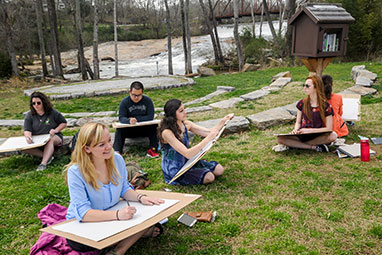Wofford College students in a beginning art class and students in an upper-level environmental studies course are using organisms that were alive over 65 million years ago to sketch — in other words they are using chalk, along with charcoal and graphite to create works of art.
The pairing of art and earth is what happens when courses collide at Wofford, and students take great benefits from the experience, says Kris Neely, assistant professor of art and coordinator of Wofford's studio art program.
"I'm a writer and poet," says Steele Smith, a first-year student from Salt Lake City, Utah. "I took the course to fulfill my art requirement, but it's opened up a different part of my brain."
Smith sat among students from both classes at Wofford's Goodall Environmental Studies Center in Glendale on a sunny March afternoon and listened to a brief lecture on the geological processes that formed the art materials they were about to use. Dr. Kaye Savage, chair of the environmental studies department and the pioneer of the course collision at Wofford, gave the lecture surrounded by students with Lawson's Fork creek at her back. Students then completed art assignments using a variety of natural materials under the direction of Nancy Lowe, an art-science catalyst visiting for the day.
"Often people don't recognize the fact that the things they are using come from the earth," says Savage, who had an epiphany while making glaze during her first pottery class. "I was only thinking about art in an art context and earth in an earth context, but some of the materials that we are using to draw were once alive – before the extinction of the dinosaurs. Understanding where the materials come from and how they were made changes the way students view both the art and the earth."
"Art and environmental studies make a great pairing," says Neely. "Helping students explore what's behind the studio process makes creating art a deeper, richer experience for our students."
While the classes also meet separately, they come together once each week in these course collisions, with a different emphasis each time, such as making watercolors from natural pigments, experimenting with clay, carving soapstone and visiting a rock quarry.
When courses collide
Combining art and earth education deepens educational experience for Wofford students